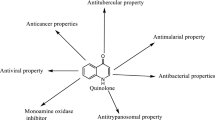Abstract
The quinolones are synthetic antibiotics chemically related to nalidixic acid. Since its introduction, several structural analogues have been synthesized. A fundamental breakthrough was the addition of a fluorine atom. The quinolones interfere with bacterial DNA transcription by inhibiting the enzyme DNA gyrase, that so far has only been found in bacteria. The nature of the activity of the quinolones on DNA gyrase makes it highly unlikely that resistance is carried on plasmids.
Similar content being viewed by others
References
Lesher GY, Froelich EJ, Gruett MD, Bailey JH, Brundage RP. 1,8-Naphthyridine derivatives. A new class of chemotherapeutic agents. J Med Pharm Chem 1962;55:1063–5.
Deitz WH, Bailey JH, Froelich EJ.In vitro antibacterial properties of nalidixic acid, a new drug active against Gram-negative organisms. Antimicrob Agents Chemother 1963:583–7.
Turner FJ, Ringel SM, Martin JF, Storino PJ, Daly JM, Schwartz BS. Oxolinic acid, a new synthetic antimicrobial agent. 1.In vitro andin vivo activity. Antimicrob Agents Chemother 1967:475–9.
Shimizu M, Nakamura S, Takase Y. Piromidic acid, a new antibacterial agent: antibacterial properties. Antimicrob Agents Chemother 1970:117–22.
Wick WE, Preston DA, White WA, Gordee RS. Compound 64716, a new synthetic antibacterial agent. Antimicrob Agents Chemother 1973;4:415–20.
De Lajaudic P. L'acide pipémidic, nouvel antibactérien de synthese. J Pharmacol Clin 1974;1:155–71.
Inoue S, Ohue T, Yamagishi J, Nakamura S, Shimizu M. Mode of incomplete cross-resistance among pipemidic, piromidic and nalidixic acid. Antimicrob Agents Chemother 1978;14:240–5.
Rohlfing SR, Gerster JF, Kvam DC. Bioevaluation of the antibacterial flumequine for urinary tract use. Antimicrob Agents Chemother 1976;10:20–4.
Ito A, Hirai K, Inoue M, et al.In vitro activity of AM-715, a new nalidixic acid analog. Antimicrob Agents Chemother 1980;17:103–8.
Shimizu M, Takase Y, Nakamura S, et al. AT-2266 a new oral antipseudomonal agent. In: Nelson JD, Grassi C, eds. Current chemotherapy and infectious disease. Washington DC: American Society for Microbiology, 1980:451–4.
Goueffon Y, Montay G, Roquet F, Pesson M. A new synthetic antimicrobial agent: 1,4-dihydro-1-ethyl-6-fluoro-7-(4-methyl-1-piperazinyl)-4-oxoquinoline-3-carboxylic acid (RB 1589). CR Acad Sci 1981;292:37–40.
Sato K, Matsurra Y, Inoue M, et al.In vitro andin vivo activity of DL-8280, a new oxazine derivative. Antimicrob Agents Chemother 1982;22:548–53.
Wise R, Andrews JM, Edwards LJ.In vitro activity of Bay 09867, a new quinolone derivative compared with those of other antimicrobial agents. Antimicrob Agents Chemother 1983;23:559–64.
Bauernfeind A, Petermüller C.In vitro activity of ciprofloxacin, norfloxacin and nalidixic acid. Eur J Clin Microbiol 1983;2:111–15.
Pohlod DJ, Saravolatz LD.In vitro susceptibilities of 393 recent clinical isolates to WIN 49375, cefotaxime, tobramycine and piperacillin. Antimicrob Agents Chemother 1984;25:377–9.
Goss WA, Deitz WH, Cook TM. Mechanism of action of nalidixic acid onEscherichia coli. 11. Inhibition of des-oxyribonucleic acid synthesis. J Bacteriol 1965;89:1068–74.
Winshell EB, Rosenkranz HS. Nalidixic acid and the metabolism ofEscherichia coli. J Bacteriol 1970;104:1168–75.
Bourguignon GJ, Levitt M, Sternglanz R. Studies on the mechanism of action of nalidixic acid. Antimicrob Agents Chemother 1973;4:479–86.
Geliert MK, Mizuchi M, O'Dea H, Nash HA. DNA gyrase: an enzyme that introduces superhelical turns in DNA. Proc Natl Acad Sci USA 1976;73:3872–6.
Geliert MK. DNA topoisomerases. Ann Rev Biochem 1981;50:879–910.
Sugino A, Peebles CL, Kreuzer KN, Cozzarelli NR. Mechanism of action of nalidixic acid: purification ofEscherichia coli nal A gene product and its relationship to DNA gyrase and a novel nicking-closing enzyme. Proc Natl Acad Sci USA 1977;74:4767–71.
Crumplin GC, Kenwright M, Hirst T. Investigations into the mechanism of action of the antibacterial agent norfloxacin. J Antimicrob Chemother 1984;13(suppl B):9–23.
Drlica K, Snyder M. SuperhelicalEscherichia coli DNA: relaxation by coumermycin. J Mol Biol 1978;120:145–54.
Sugino A, Higgins NP, Brown PO, Peebles CL, Cozzarelli NR. Energy coupling in DNA gyrase and the mechanism of action of novobiocin. Proc Natl Acad Sci USA 1978;75:4838–42.
Engle E, Maives S, Drlica K. Differential effects of antibiotics affecting gyrase. J Bacteriol 1982;149:92–8.
Shen L, Tricarico K, Pernet AG. Mechanism of inhibition of DNA gyrase by quinolone antibacterial agents: the target of the drug is DNA. In: 24th Interscience Conference on Antimicrobial Agents and Chemotherapy, Washington DC, October 8–10, 1984. Washington CD: American Society for Microbiology. 1985: abstract 978.
Hane MW, Wood TH.Escherichia coli K-12 mutants resistant to nalidixic acid: genetic mapping and dominance studies. J Bacteriol 1969;99:238–41.
Author information
Authors and Affiliations
Rights and permissions
About this article
Cite this article
Verbist, L. Quinolones: pharmacology. Pharmaceutisch Weekblad Scientific Edition 8, 22–25 (1986). https://doi.org/10.1007/BF01975474
Received:
Accepted:
Issue Date:
DOI: https://doi.org/10.1007/BF01975474




